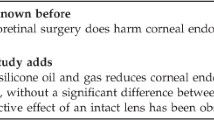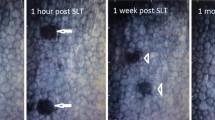Abstract.
Background: The purpose of this study was to quantify breakdown of the blood-aqueous barrier (BAB) following penetrating keratoplasty (PK) with simultaneous extracapsular cataract extraction and posterior chamber lens implantation (triple procedure) and compare it with the alterations following PK only. Methods: This study included 72 eyes after triple procedure and 227 eyes after PK only. The diagnosis for PK was Fuchs´ dystrophy in 39%, keratokonus in 44%, stromal corneal dystrophy in 3% and avascular corneal scars in 6% of cases. The postoperative topical steroid treatment was standardized in both groups. Aqueous flare was quantified using the laser flare-cell meter (FC-1000, Kowa) at defined postoperative intervals (10 days , 6 weeks, then every 3 months until 1 year postoperatively). Patients with conditions associated with impairment of the BAB were excluded from the study. Results: In the early postoperative course, aqueous flare values (photon counts/ms) were significantly higher in patients with triple procedure (21.9±11.0) than in patients with PK only (9.8±3.2; P=0.001). At 6 weeks postoperatively, aqueous flare returned to normal levels in patients after PK only (5.2±2.3), whereas patients with triple procedure still showed significantly increased flare values (10.8±5.6; P=0.01). At 6 months postoperatively, aqueous flare values of patients with triple had returned to normal levels (6.8±3.8) and did not differ significantly from those after PK only (5.2±1.9; P=0.09). Conclusion: Our results indicate that triple procedure causes a more extensive and longer-lasting breakdown of the blood-aqueous barrier than PK only. Quantification of aqueous flare with the laser flare-cell meter is useful in the postoperative follow-up after triple procedure. Further studies are required to investigate the clinical relevance of BAB breakdown on endothelial cell count and the incidence of subsequent immunological graft rejection.
Similar content being viewed by others
Author information
Authors and Affiliations
Additional information
Electronic Publication
Rights and permissions
About this article
Cite this article
Nguyen, N.X., Langenbucher, A., Seitz, B. et al. Blood-aqueous barrier breakdown after penetrating keratoplasty with simultaneous extracapsular cataract extraction and posterior chamber lens implantation. Graefe's Arch Clin Exp Ophthalmol 239, 114–117 (2001). https://doi.org/10.1007/s004170000244
Received:
Revised:
Accepted:
Issue Date:
DOI: https://doi.org/10.1007/s004170000244




